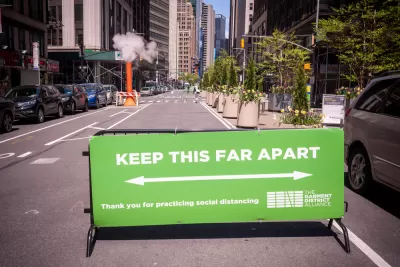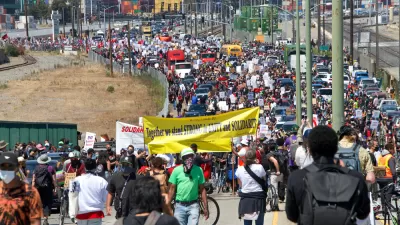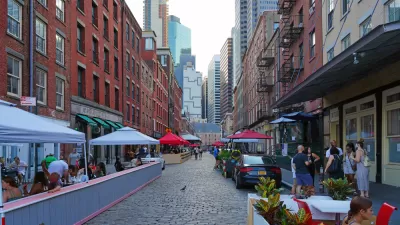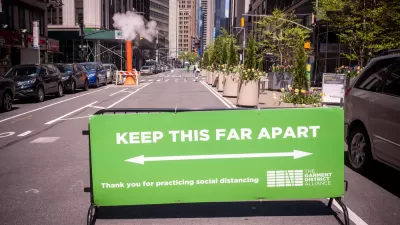New York City has opened an increasing number of street miles for pedestrians and people on bikes, but far fewer streets have been opened in the neighborhoods that need it most—low income neighborhoods lacking walkable access to parks and open space.

"Public space for social distancing is hard to find in many of New York City’s low-income neighborhoods," reports Clayton Guse.
That conclusion is made possible by a map published recently by the Trust for Public Land. "The map reveals inequities in Mayor de Blasio’s move to open up 30 miles of streets for pedestrians during the coronavirus pandemic," according to Guse.
The map overlays the open streets opening in New York City, overlaid on a map of walkable proximity to park and open space. "Neighborhoods like Brownsville in Brooklyn and Elmhurst in Queens contain large swaths that are more than a 10-minute walk from an open public park," explains Guse. "But parts of those neighborhoods have been left out of the city’s plan to ban cars from some streets as a relief valve for people on foot."
On May 22, a day after the TPL map was published, New York City announced 13 new miles of open streets and claimed to have the most miles of open streets of any city in the country, according to an article by Gersh Kuntzman.
FULL STORY: De Blasio’s move to open NYC street to pedestrians leaves out low-income neighborhoods, map shows

Montreal Mall to Become 6,000 Housing Units
Place Versailles will be transformed into a mixed-use complex over the next 25 years.

Planetizen Federal Action Tracker
A weekly monitor of how Trump’s orders and actions are impacting planners and planning in America.

DARTSpace Platform Streamlines Dallas TOD Application Process
The Dallas transit agency hopes a shorter permitting timeline will boost transit-oriented development around rail stations.

Interactive Map Reveals America's “Shade Deserts”
Launched by UCLA and American Forests to combat heat-related deaths, the tool maps the shade infrastructure for over 360 U.S. cities.

Bicycles and Books — In Sacramento, Libraries Now Offer Both
Adult library card holders can check out e-bikes and e-trikes for up to one week.

Colorado Landfills Emit as Much Pollution as 1M Cars
Landfills are the third-largest source of methane pollution in Colorado, after agriculture and fossil fuel extraction.
Urban Design for Planners 1: Software Tools
This six-course series explores essential urban design concepts using open source software and equips planners with the tools they need to participate fully in the urban design process.
Planning for Universal Design
Learn the tools for implementing Universal Design in planning regulations.
City of Mt Shasta
City of Camden Redevelopment Agency
City of Astoria
Transportation Research & Education Center (TREC) at Portland State University
US High Speed Rail Association
City of Camden Redevelopment Agency
Municipality of Princeton (NJ)





























